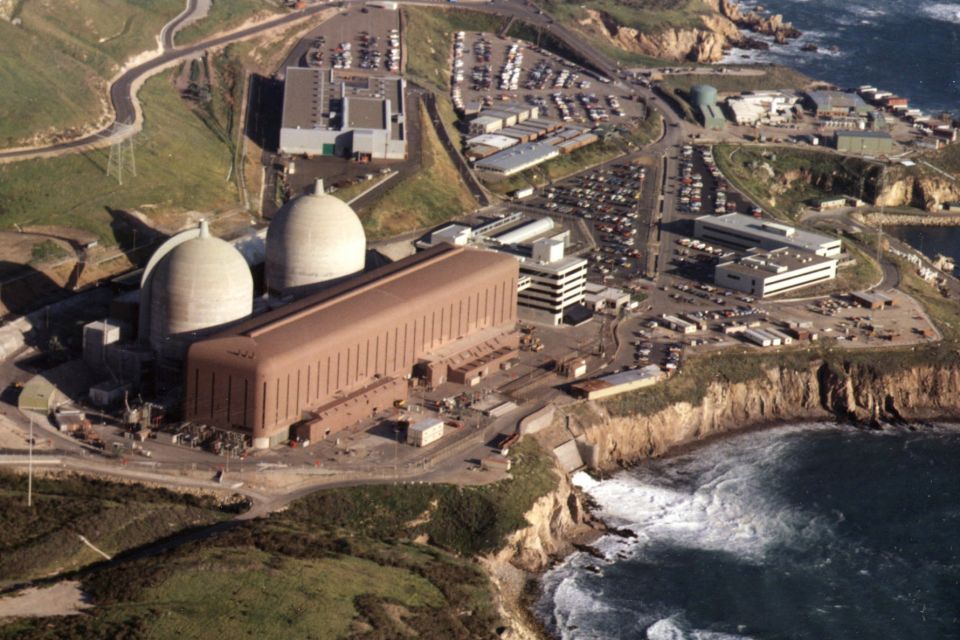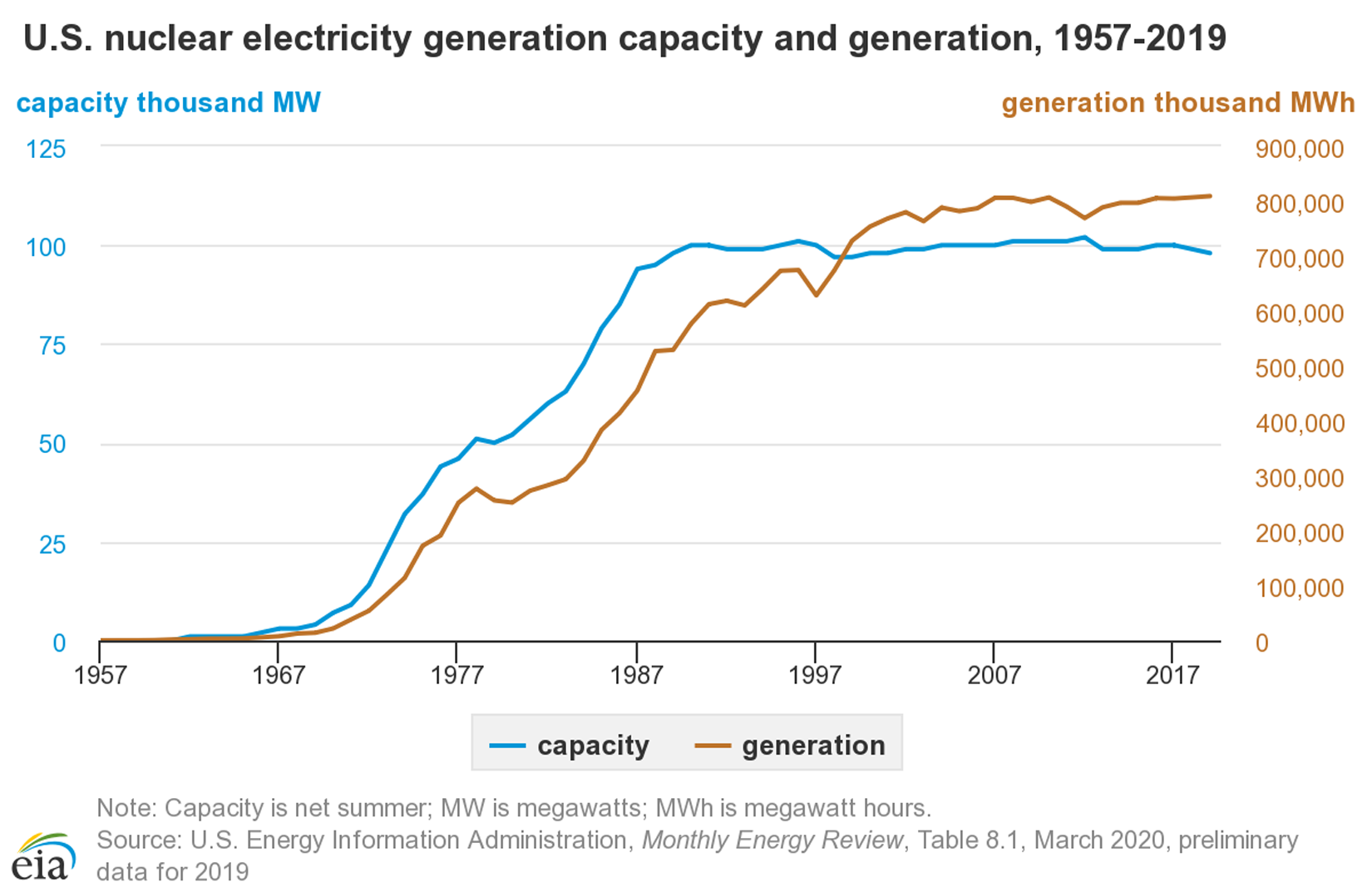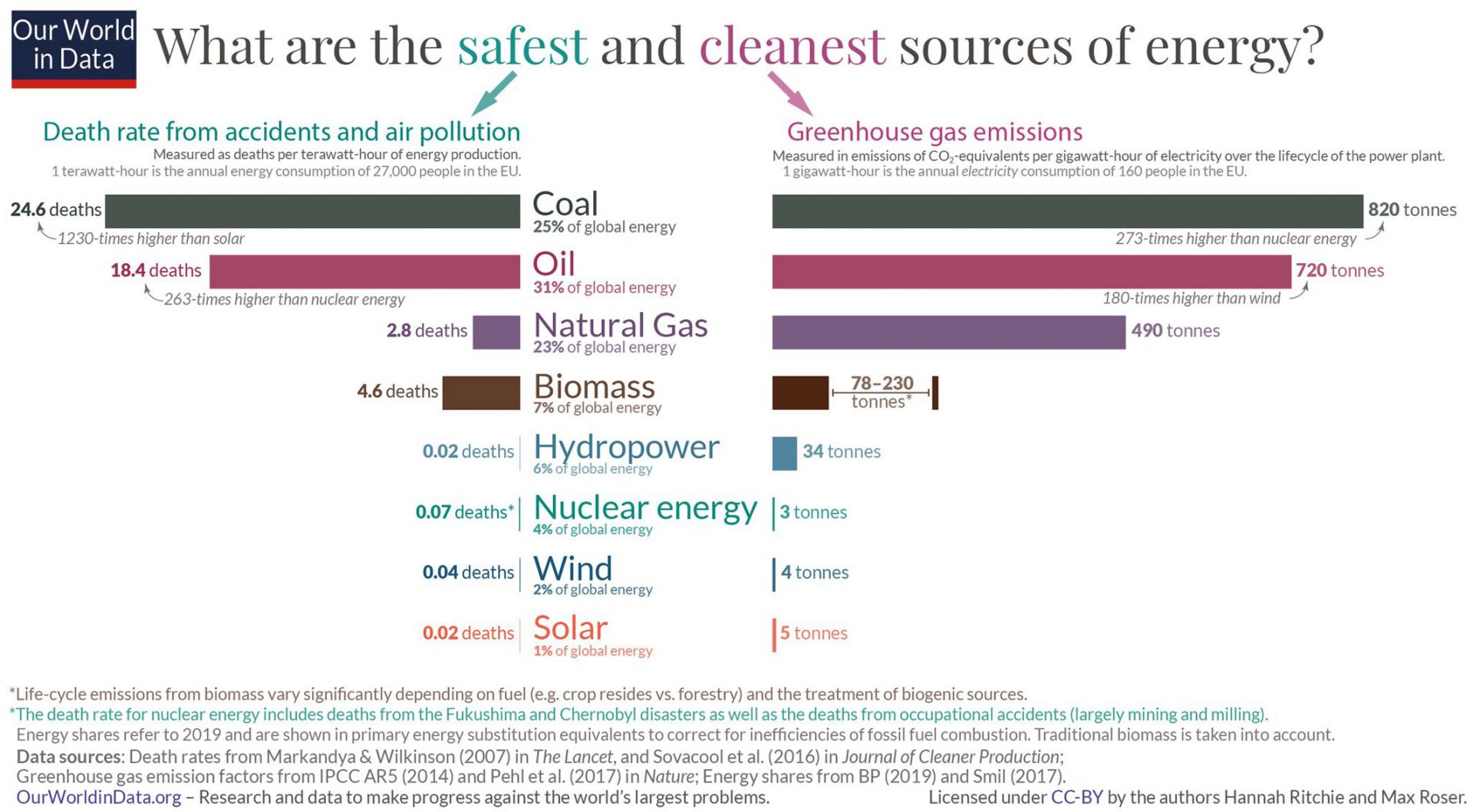This article was way too big to post all of it, open the link to read the rest.
https://www.ans.org/news/article-34...g-the-industry-narrative-for-a-strong-future/
Becoming agile and innovative in an evolving nuclear landscape: Changing the industry narrative for a strong future
Tue, Nov 30, 2021, 12:00AMNuclear NewsGleb Tsipursky
Diablo Canyon nuclear plant. (Photo: PG&E)
Last April, Entergy had to close its Indian Point nuclear plant. That’s despite the plant’s being recognized as one of the best-run U.S. nuclear plants. That’s also despite its 20-year license extension process having been nearly completed, with full support from the Nuclear Regulatory Commission.
This closure was due in large part to opposition by antinuclear environmental groups. These groups also mobilized existing negative public opinion on nuclear energy to get politicians to oppose the plant’s license extension. Another factor is unfair market conditions. Nuclear energy doesn’t get due government support—unlike solar, wind, and hydro—despite delivering clean, zero-emissions energy.
And then, there’s the pressure from environmental, social, and governance (ESG) investors, who have become increasingly powerful in the energy space. In fact, they recently forced their candidates onto Exxon Mobile’s board of directors, against the opposition of Exxon leadership.
These issues may seem familiar to you, because these challenges have led to recent nuclear plant closures, such as NextEra’s Duane Arnold nuclear plant, Entergy’s Indian Point, and many others.
This is happening in America, the home of the nuclear energy industry. Yet we only get 20 percent of our energy from nuclear power. Nuclear has been slowly declining for many years, and the U.S. Energy Information Administration projects that trend to continue unless we make a serious effort to reverse it.
Negative perceptions due to misleading narrative
Much of the industry’s difficulty comes from the misleading narrative by antinuclear, antibusiness environmental activists. They have convinced the public to see nuclear energy in a negative light, on everything from its health impacts to its consequences for the environment.
For example, only 46 percent of the population believes that nuclear power helps limit global warming, according to an Organisation for Economic Co-operation and Development survey. That means that 54 percent of the population doesn’t have the right facts about the impact of nuclear on the environment. Unfortunately, the nuclear industry is failing to combat this narrative effectively.
This narrative is the root cause of tangible threats facing the industry. You see these threats every day in the form of license extension challenges, the decrease in plant profitability, the impeded construction of new plants, excessive regulatory burdens, pressure from ESG investors, and disruptive competition from startups.
It doesn’t have to be like this. It really can’t be like this, for our kids and grandkids. This article will help illuminate the dangerous threats facing nuclear energy. It will then provide pragmatic and practical solutions to overcome these challenges to build a strong future for the nuclear industry and for America.
International comparison
To get a broader comparative context, let’s talk about nuclear in France.
France is a large, diverse, and economically developed country, similar to the U.S. in many ways. However, environmentalists in France have much more power than in the U.S.
For example, a 2003 poll on energy policy revealed that 67 percent of the French populace believes that environmental protection represents the single most important energy policy goal. Of course, environmentalists have only become stronger since 2003.
French environmentalists and nuclear
Now, consider a recent story from France of environmentalist protests around the closing of a French nuclear plant. Take a few seconds to close your eyes and imagine what the protests there must be like. You might be picturing protesters with antinuclear signs, chanting the French version of “no nuclear” outside a French nuclear plant. In reality, what happened is the complete opposite. French environmentalists protested outside the office of the French branch of Greenpeace. This happened after Greenpeace pressured the French government to close a French nuclear plant.
Right after the closure, Greenpeace found its office the target of protests from pronuclear environmentalists. That’s right, you read correctly: pronuclear environmentalists. These protesters shouted that less nuclear energy means more coal energy and that nuclear power is better for the climate.
Their message aligns well with French public opinion. A poll taken immediately after the 2011 Fukushima plant accident showed that the French see nuclear energy as safe. At a time when the nuclear industry was suffering from an especially bad image, 62 percent of the people in France—more than enough to win an election—said they trusted the nuclear industry to keep them safe.
In comparison, a survey taken in the U.S. in 2019—long after Fukushima and with no subsequent nuclear accidents—revealed the opposite. Only 47 percent of Americans—more than enough to lose an election—see nuclear plants as safe.
Considering the French people’s strong support for the nuclear industry, it’s no wonder the country gets over 70 percent of its electricity from nuclear energy. But why are the French doing so much better than we are? Do they have better technology? No! In fact, France got all its nuclear technology from the U.S. in the 1970s.
The answer is not technical; it’s psychological. France has a much better psychological approach to the matter. Its nuclear industry uses techniques that recent behavioral science research has proven effective at controlling the narrative.
For instance, French leaders worked hard to highlight the benefits of nuclear energy through advertising campaigns. They were successful in reinforcing the link between nuclear power and the electricity that makes modern comfort possible.
Heads of nuclear plants also encourage people to take tours to demonstrate how safe nuclear power is. Many millions of French citizens have gone on such tours. It has made them less afraid and more comfortable with nuclear energy.
In addition, all nuclear workers—from plant engineers to managers to staff-level workers—are active advocates. They publicly communicate the benefits of nuclear energy to fellow citizens every day as part of their work. This decreases fear and promotes trust and comfort.
All these key actions add up to the French nuclear industry’s control of the narrative. It’s the reason that today, nuclear energy is an everyday and casual thing in France. It’s not perceived as something scary, mysterious, and unsafe, as so many U.S. citizens feel.
French effect at addressing issue of nuclear waste
An excellent example of this mastery of the narrative is how France coped with the problem of nuclear waste. This is a huge issue for nuclear here in the U.S. but a much smaller problem in France.
Nuclear waste used to be a much bigger problem for the French. It almost derailed the nuclear industry’s growth in the 1980s.
Naturally, given its high nuclear usage, France produces substantial nuclear waste. French nuclear industry leaders with engineering and science backgrounds looked at the problem in technical terms. They saw the cheapest and safest solution as permanent burial. However, when they started digging exploratory holes in rural regions, they encountered massive opposition from the people in those regions. Riots and protests ensued. Eventually, this became a very big challenge for the leaders.
France did not take the road of hunkering down and trying to push through the opposition to permanent underground storage, unlike the sad story of the Yucca Mountain nuclear waste repository. France adopted a different path. The government appointed a well-respected politician, Christian Bataille, to figure out a solution.
Bataille talked to the protesters and figured out that scientists and engineers misunderstood the psychology of the rural French. He discovered that the rural people viewed nuclear waste as being caused by wealthy urbanites and dumped on them. They felt that the authorities were abandoning the waste and that they would be stuck with it forever. The rural French saw it as all cost and no benefit.
In turn, Bataille advocated for introducing the notions of research, reversibility, and stockpiling. He argued that spent nuclear fuel should not be buried permanently. Rather, it should be stored in a way that makes it accessible at some time in the future.
In the meantime, scientists investigated ways to use a bigger percentage of the spent fuel. They also researched how to transmute the minute fraction of spent fuel that can’t be used from long-term waste of many thousands of years to short-term waste of a couple of centuries or even decades.
Bataille fought against the objections of technical experts who said it would increase costs. He stressed that his plan was not just a semantic difference. Research, stockpiling, and reversibility involved a commitment: It meant that the authorities would continue to be responsible and would research ways to improve the situation.
Then, he proposed building research labs to explore options for stockpiling waste. He also suggested the idea that one of them would be picked as a long-term site of the research lab and stockpiling center.
Bataille was right. People felt much happier with the idea of a nuclear waste stockpiling center and lab rather than a nuclear waste dump, and several regions applied to host the labs. They did so because they considered it as a source of revenue and good jobs. Now wouldn’t it be nice if U.S. states and municipalities competed to be the place where spent nuclear fuel is researched and stockpiled?
If the French can control the narrative, so can the American nuclear industry. It’s the responsibility of everyone in the U.S. nuclear industry to shift the American narrative on nuclear energy. No matter where you are in the industry—how high or how low, how important or insignificant you consider yourself to be—you need to play your part for the strong and bright future of nuclear in the United States.
From 2017 study by Our World In DataClosing nuclear plants is literally deadly
No wonder nuclear saves so many lives. Even if you use the worst-case, hostile-to-nuclear assumptions and you replace nuclear with the least dangerous fossil fuel, gas, you still kill many dozens of people per plant.
For example, replacing a nuclear plant the size of Indian Point that produces 16 terawatt hours per year with the least dangerous form of fossil fuel, gas, will kill more than 45 people per year. If you use a 50 percent mix of gas and coal, more than 250 people would be killed per year.
Shutting down nuclear plants is literally deadly. Each closure kills anywhere from many dozens to hundreds per year due to replacement by fossil fuel electricity. This means replacing a nuclear plant with fossil fuel–burning plants results in anywhere from many dozens to hundreds of people killed each year. It’s clear that closing nuclear plants is literally deadly dangerous.
Burdensome regulations on nuclear are killing many people right now as you read this article. This should be an outrage!
These problems are caused by negative public emotions on nuclear. They are all solvable, and it’s your job to solve them using behavioral science–based strategies.
fficials rather than shifting public opinion. Keep in mind that lobbying officials instead of swaying the public can get you short-term gains, but this often backfires and hurts nuclear.
Consider a particularly egregious example from my hometown of Columbus, Ohio. Two years ago, state lawmakers passed a $1.3 billion subsidy to save two nuclear plants. However, new information came to light about some shady payments to Ohio lawmakers by the company that ran the plants. This led to federal indictments of lawmakers and resignations of top executives at the nuclear company. The company had to pay a huge fine, and the subsidy was repealed. The public image of nuclear was badly damaged.
Now there’s no way that even the best nuclear company will get a subsidy in Ohio for the next few years. That’s a very disappointing outcome for me and all others who support a bright future for nuclear.
That was an extreme and egregious example, but it represents a broader tendency. Way too much of the nuclear industry’s efforts are about lobbying officials. It doesn’t focus nearly enough on swaying the public.
Focusing on seizing control of the narrative is the key to your long-term success. Other issues are related to this. As mentioned earlier, if you seize control of the narrative, you can decrease your costly regulatory burden and address unfair market conditions.
Conclusion
A top nuclear executive told me that the nuclear industry is like a huge cruise ship trying to turn to miss the big iceberg of the nuclear twilight. Unfortunately, the industry’s efforts to turn the cruise ship right now seem to be on cruise control. It’s obvious that there’s a lot of work that needs to be done, and soon.
The future of nuclear power is strong and bright if you avoid complacency and choose to be masters of your destiny. Nuclear needs to position itself as the big brother of solar and wind if you want to grow into the biggest source of electricity in America.
You think it can’t be done? Remember the example of France. What you need to do is take the wheel. Go full steam ahead to a “green nuclear” future by seizing control of the narrative and using nuclear psychology.
What gives me hope is seeing smart money like Bill Gates going all-in on nuclear. He sees the true potential of nuclear and wants to grab the profits and glory for himself. You can’t let him do that.
To position nuclear for a strong future, everyone in the U.S. nuclear industry should advocate for its growth and continued existence. This means seizing control of the narrative by speaking the language of environmentalism, talking about protecting public health, and appealing to ESG investors.
You should pivot your strategy accordingly to protect existing nuclear plants, focus on developing SMRs, and invest in startups.
You also need to escape the complacency of cruise control by not ignoring the threats outlined in this article. Take advantage of the solutions proposed if you want to avoid the iceberg of the nuclear twilight.
If you do so, you’ll become agile and innovative for a strong future for nuclear. Now go out there and seize your destiny!
- Forums
- ASX - By Stock
- Nuclear Power Related Media Thread
SLX
silex systems limited
Add to My Watchlist
0.24%
 !
$4.16
!
$4.16
This article was way too big to post all of it, open the link to...
Featured News
Add to My Watchlist
What is My Watchlist?
A personalised tool to help users track selected stocks. Delivering real-time notifications on price updates, announcements, and performance stats on each to help make informed investment decisions.
 (20min delay) (20min delay)
|
|||||
|
Last
$4.16 |
Change
0.010(0.24%) |
Mkt cap ! $990.5M | |||
| Open | High | Low | Value | Volume |
| $4.11 | $4.20 | $4.00 | $4.874M | 1.183M |
Buyers (Bids)
| No. | Vol. | Price($) |
|---|---|---|
| 2 | 16444 | $4.12 |
Sellers (Offers)
| Price($) | Vol. | No. |
|---|---|---|
| $4.16 | 245 | 1 |
View Market Depth
| No. | Vol. | Price($) |
|---|---|---|
| 2 | 16444 | 4.120 |
| 2 | 3500 | 4.020 |
| 1 | 500 | 4.010 |
| 4 | 5086 | 4.000 |
| 1 | 10000 | 3.960 |
| Price($) | Vol. | No. |
|---|---|---|
| 4.160 | 245 | 1 |
| 4.200 | 6574 | 2 |
| 4.300 | 3500 | 1 |
| 4.350 | 5107 | 2 |
| 4.380 | 1223 | 2 |
| Last trade - 16.10pm 08/07/2025 (20 minute delay) ? |
Featured News
| SLX (ASX) Chart |







